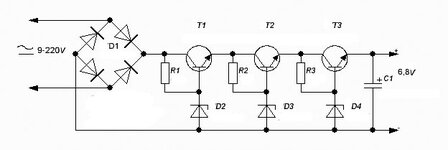neazoi
Advanced Member level 6
Hi,
I want to convert a 6v-12v AC or DC source (both needed) to 5v stabilized DC <100mA.
The obvious way is to use a bridge rectifier, followed by a 78L05.
However, the bridge and the regulator is not an LDO, so I believe that there could be a problem converting from 6v to 5v.
I would like to use the simplest solution with common parts (not special ICs) and no switching regulators, due to RF noise concerns.
I want to convert a 6v-12v AC or DC source (both needed) to 5v stabilized DC <100mA.
The obvious way is to use a bridge rectifier, followed by a 78L05.
However, the bridge and the regulator is not an LDO, so I believe that there could be a problem converting from 6v to 5v.
I would like to use the simplest solution with common parts (not special ICs) and no switching regulators, due to RF noise concerns.

